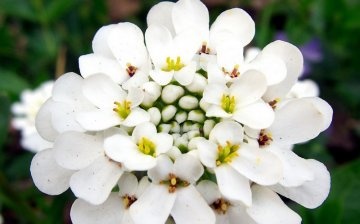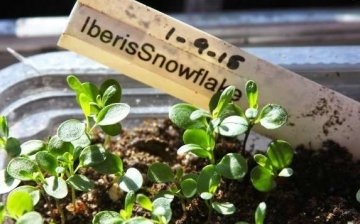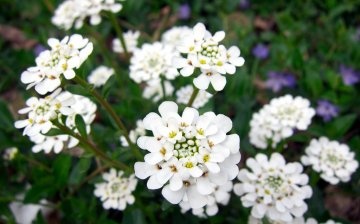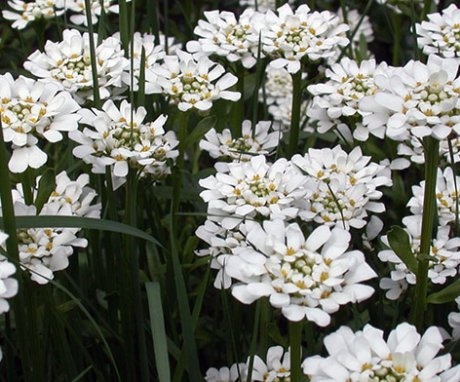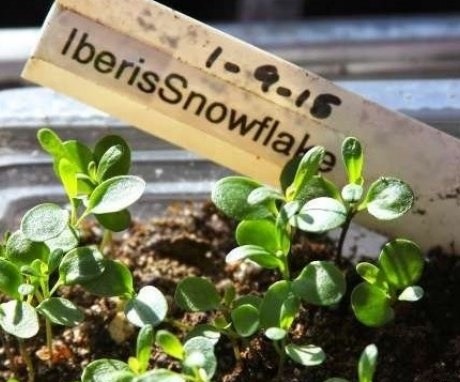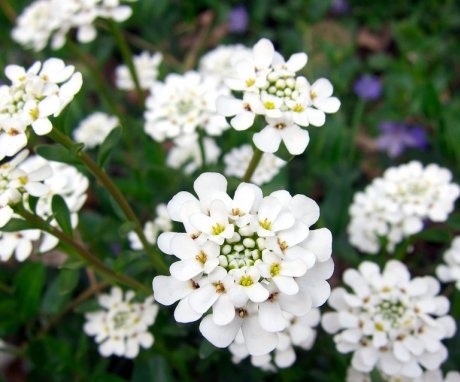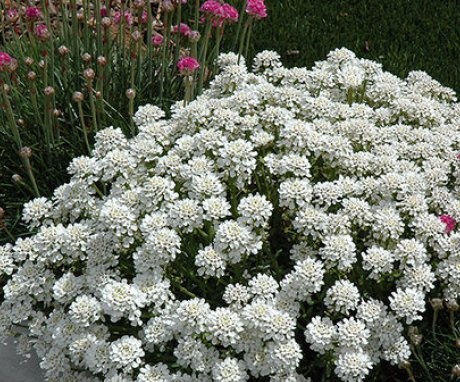Iberis evergreen - unpretentious undersized shrub
Spring gardening requires interesting solutions. It is necessary to arrange the plants so that they set off others, so that the natural chaos looks original and not overused. One of the flowers that give the garden a graceful look is Iberis evergreen.
Content:
- Description of the plant
- Breeding methods and planting
- Care tips: watering and feeding
- Diseases and pests
- Application
Description of the plant
The original residence of the bush in Spain. In ancient times, Spain was called Iberia, and the flower grew on the slopes of the Iberian mountains. Hence its name. In appearance it resembles fluffy clouds. It belongs to the subspecies Cruciferous of the cabbage genus, but it is not an edible plant, it does not even produce fruits, only seeds.
Iberis known under many names - Stennik, Razolepestnik, Golden Flower.
Its main advantages are its beautiful appearance and aromatic smell. Ejection of buds is observed in May and lasts for 60 days.
The bush itself is undersized, grows no more than 50 cm in height, but branches very strongly. The leaves are of a dark green shade, elongated and small in size (up to 3 cm in length, and no more than 0.5 cm in width), densely spaced to each other. The branches have an interesting structure: at the base there are tree-like shoots, and closer to the top they turn into green shoots. Spreading shoots, erect, stretching upward.
The color is plentiful, lush, covering all the top greens. Evergreen Ibiris has white flowers, collected in racemose inflorescences of 30-40 pieces. The diameter of the bud is up to 1.5 cm.
Iberis Evergreen is one of 40 types known to gardeners. Also the most popular types are:
- Bitter - undersized bush no more than 30 cm tall. The shade of the petals is white with a slight violet tone.
- Umbrella - one-year-old, is 40 cm in height. Inflorescences are dense, colors of different tones from pink to lilac. Lavish fragrant smell.
- Gibraltar is a shrub with corymbose bunches of flowers. Perennial plant, purple buds.
Thus, the shrub is of short stature, of an interesting structure, both leaves and inflorescences. Differs in a fluffy look and original presentation of flowers.
Breeding methods and planting
It is possible to purchase the Razorpetal both in seeds and as a ready-made sprout. When buying, you should carefully examine the plant for disease. If the pot with a bush is less than 10 cm, you should not take it, since the root is then not sufficiently developed and will not be able to take root. If the leaves of the shoot are yellow - a clear sign of the disease, it is also not recommended to take it to your site.
Dividing the root system is possible, but not desirable. Usually this method is used at the age of 5. The stems of the shrub are greatly shortened. If not transplanted, then the flowers begin to shrink.
Propagation by cuttings is carried out after flowering... Cut off shoots without an ovary 10 cm long. The stepson should grab part of the ligneous branch and green shoots. Up to 4 shoots are placed in one pot, covered with foil. As the soil dries out, the cutting is opened and watered, thereby airing and hardening.In the spring they are planted for permanent residence.
There are two ways to grow seeds:
- Directly into the ground. Planting takes place in mid-April, when spring frosts do not bother, the air temperature rises to + 10 + 150C, the soil gradually warms up. The holes are dug up to 10 cm deep. If the temperature is + 18 + 200C, then the first shoots will appear in 7-10 days. If the air warms up to only + 150C, the seedlings will delight only after 14-20 days. When planting, you should take into account the spreading and immediately plant at a distance of 20-25 cm from each other. Otherwise, you will have to remove the extra germinated seeds.
- Planting seedlings. The seeds are sown on seedlings in March to a depth of 1 cm, observing greenhouse conditions. The container with seeds is placed in a sunny place, covered with either a plastic bag or glass on top. When the soil dries out, it is necessary to open and water, it is advisable to irrigate with a spray bottle so as not to wash the seeds. After the first shoots appear, it is recommended to harden them. Open the container periodically and put it in fresh air. When young bushes reach 7 cm, they can be planted in an open flower bed. It should be transplanted with a lump of earth, without shaking off the soil from the roots. During the transshipment process, the upper bud is necessarily pinched off for branching.
Care tips: watering and feeding
Iberis evergreen - simple and unpretentious to care for. For good seed germination and healthy growth, you must adhere to some rules:
- The right choice of place - loves the sun's rays, does not accept shade. Even a slight shade contributes to the stretching of the shoots, drying out and dropping of the buds.
- Defined soil composition - sandy, rocky soil with good oxygen circulation.
- Optimal watering - in dry periods, abundant, but rare.
- High-quality feeding is not required, but if you feed it, it will delight you with abundant color and aroma.
- Moderate watering is necessary due to the fact that the root system does not tolerate stagnant moisture - the roots immediately begin to rot.
- Care feature - you need to maintain a compact size. Faded buds and stems are cut off. When the seeds ripen, along with the capsules, the stems are removed by 1/3 of the total length of the branch.
Fertilizing with mineral fertilizers can be done no more than 2 times a year:
- complex feeding in spring
- during bud formation
After pruning for the fall, they are introduced into the soil compostby digging evenly around the bush. You should not overdo it with fertilizers, if the earth is oversaturated with useful minerals, then Stennik grows rapidly, becomes loose, ceases to be compact and neat. Thus, moderate watering and small portions of dressing hello to a healthy flowering species of Iberis evergreen.
Diseases and pests
The shrub is more resistant to diseases and pests. But in rare cases, it is affected by the following pests:
- Rhizoctonis - in a cold spring with constant rains, gray spots appear on the roots and at the base, the shoots die. For treatment, a solution of lime and fertilizers is added to the soil, the earth is disinfected with special fungicides... Completely dead bushes are destroyed by burning.
- The earthen flea is a beetle that eats leaves. The growth takes on uneven outlines. Tracks are observed inside the green cover structure. For treatment, insecticides are used, as well as regular soil moistening.
- Mealybug is an insect that sucks juice. It is necessary to remove and process representatives of garlic tincture or soapy water. In case of a large invasion, only chemical treatment will save.
- Cruciferous keel - the appearance of a fungus in the ground. The disease forms growths on the roots that stop development and growth. Leaves change color to pale yellow, wither. The disease is reflected more clearly on young shoots. The disease is incurable.The only struggle is before planting, the seeds are treated with chemicals.
- Cabbage aphid - sucks out the juice, killing the plant. White spots appear on the leaves, a week after infection, the shoots dry out, the buds wither and fall off. Treatment - the use of tobacco broth and chemicals (sulfate-anabasine).
Thus, small pests can cause irreparable harm and destroy the flower. Proper care and constant monitoring of the condition will help to notice the signs of the disease at first.
Application
Iberis - the first messenger of heat. In order for the bush to give early flowers, it is planted before winter in a place prepared in advance, then the first buds will be in May.
The golden flower is grown on balconies, in pots, in open flower beds, in flower beds, on flower walls. With its help, interesting alpine slides are performed. They form a decor in the style of "Natural chaos", where neat white balls are placed in the crevices. In addition, they are used for cutting - they stand in the water for a long time.
Suitable for framing flower beds, as well as for landscaping lawns as a single decor, and in a pair with other types.
Near the Iberis is grown tuberous begonias, phloxes, saxifrage, sedum... White edges favorably set off bright floral arrangements. On alpine slides, they are planted in such places and on surfaces in order to visually smooth out protruding sharp edges. To keep the flower compact and rounded, it is formed. Pruning is done immediately after flowering.
In addition, in order for Iberis to bloom longer, a little trick is used: the planting time is torn by 2 weeks. Thus, each planted shoots later bloom 2 weeks later at a different time, and the effect of constant flowering is obtained. To obtain interesting colors, Iberises of various types are planted nearby. With cross-pollination, completely extraordinary flowers with intricate shades bloom. Thus, the use of the shrub is quite extensive. White clouds effectively set off the dark tones of other colors. By planting a shrub in the garden, you can create a unique masterpiece.
More information can be found in the video:



